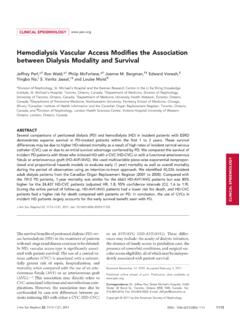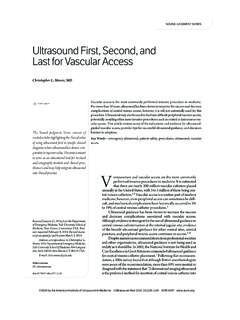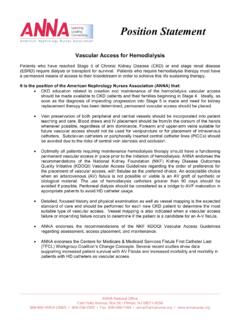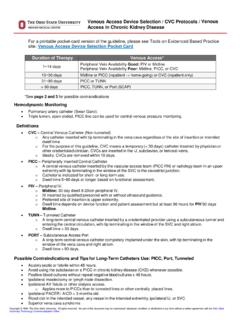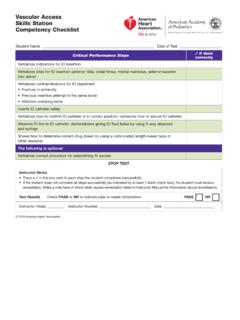Transcription of Introduction to Vascular Access for Hemodialysis
1 THE ACHILLES HEEL OF HD R E Z A K H O R S A N M . D . A U G U S T 2 7TH 2 0 1 4 Introduction to Vascular Access for Hemodialysis Three Main Options For Vascular Access Arterio-Venous Fistulas (AVFs) Arterio-Venous Grafts (AVGs) Tunneled and Non-tunneled Central Venous Catheters (CVCs) AVFs are preferred due to long term superiority and less complications In the higher rates of AVGs vs. AVFs What are AVFs? Direct connection of artery to vein Non-physiologic by design Normal radial blood flow is 20-30 ml/min AVF run blood flows between 600-1200 ml/min Overtime higher flows through vein causes arterialization and maturation of vein to be used in HD General Rule: Prefer to start distally at the wrist then work proximal Artery side to vein-end anastomosis is the preferred technique Scribner Shunt Cimino-Brescia Fistula Radial artery to Cephalic Vein anastomosis @ wrist Developed in 1966 and still preferred mode of Access !
2 Brachial Artery to Cephalic Vein and Ulnar Artery to Perforating Vein Advantages of AVFs Good blood flow Lower incidence of infection vs. AVGs and CVCs Lower tendency to clot vs. AVGs and CVCs Stays functional longer Decreased mortality and morbidity compared to AVGs and CVCs Disadvantages to AVFs Higher rates of primary failure compared to AVGs Can take several months to mature (need early referral) May be more difficult to puncture compared to grafts May be less cosmetically pleasing to patients compared to grafts Examples of Dilated AVFs Order of Preference for AVFs Radiocephalic Brachiocephalic Transposed brachiobasilic fistula Other less common fistulas Arterio-Venous Graft Usually made of polytetrafluoroethylene (PTFE) Conduit between artery and vein Not preferred for initial Access Indications include hypoplastic or exhausted peripheral vein, obesity, or severe arterial occlusive disease ( Many of HD patients)
3 Types of AVGs Straight forearm (radial artery to cephalic vein) Looped forearm (brachial artery to cephalic vein) Straight upper arm (brachial artery to axillary vein) Looped upper arm (axillary artery to axillary vein) Less common are looped lower extremity (femoral artery to axillary vein) when other options are exhausted Types of AVGs AVGs Preferred placement is looped in forearm Post-operatively may seem infected: redness, heat, swelling around graft. Should resolve in 2 weeks without need for antibiotics Advantages of AVGs Initial high blood flow rates First cannulation 2-3 weeks vs.
4 2-3 months Easy surgical replacement Less primary failure than AVFs (may be as high as 40%) Monitoring and Surveillance of AVFs and AVGs Inspect for infection, hematoma, swelling, and palpation for venous stenosis Impaired Access if < 600 ml/min in AVG or 300 ml/min for AVF (usually checked with glucose dilutional technique) Pre-emptive intervention to prevent thrombus of utmost importance Complications of AVFs and AVGs Thrombosis is a more frequent complication in AVGs than AVFs; usually due to venous outlet stenosis Thrombosis more likely to happen with area cannulation technique Complications of AVFs and AVGs In AVGs stenosis usually occurs at the graft-vein anastomosis due to neo-intimal hyperplasia1 Complications of AVFs and AVGs Most common complication thrombosis Treatment of thrombosis in both uses a combination of thrombolytics and thrombectomy techniques Even after successful declotting, it is important to always treat underlying stenosis, otherwise thrombosis will always recur.
5 Procedures on AVFs/AVGs Most common indications are inadequate flow, thrombosis, and failure to mature Procedures include angiography, thrombectomy, angioplasty, and stenting Percutaneous Balloon Angioplasty Used to relieve stenosis Usually used if stenosis is greater than 50 % with clinical symptoms or poor blood flow Considered successful in no more than 30 % stenosis after procedure Cannot perform if AVF less than 4-6 weeks old Techniques include thrombo-aspiration and mechanical and pharmo-mechanical thrombolysis Percutaneous Thrombectomy Complications of AVFs and AVGs Prevention of AVF/AVG thrombosis?
6 Randomized controlled trials with Coumadin1 and aspirin and plavix2 did not show benefit Fish oil may have small benefit3 Complications of AVFs and AVGs Aneurysms and false aneurysms may develop Usually due to repeated area cannulation Should be resected Can lead to infection in AVGs Aneurysms Complications of AVFs and AVGs Steal phenomenon and steal syndrome can develop due to retrograde blood flow Grade I: pale/blue and/or cold hand without pain Grade II: Pain during exercise and/or HD Grade III: Ischemic pain @ rest Grade IV: Ulceration, necrosis, or gangrene of hand or digits Complications of AVFs and AVGs High flow steal syndrome can be treated with venous banding, but this may cause more clotting Normal flow steal syndrome can be treated by DRIL procedure (Distal Revascularization and Interval Ligation)
7 Cardiac Overload in AVFs and AVGs High output heart failure due to AVF or AVG is not common except in patients with advanced cardiac disease Flow exceeding 1000 ml/min or flow/cardiac output ratio greater than concerning for Access contributing to cardiac decompensation Ligation and narrowing of fistula can be attempted to salvage AVF or AVG Infections of AVFs and AVGs Not common in AVFs. If no purulent drainage, 2 week course of antibiotics can be attempted In AVGs infections are more common If infection involves anastomotic area, removal of all graft material necessary Midgraft infections can be treated with 2 weeks of IV antibiotics, followed by 4 weeks of oral antibiotics Central Venous Dialysis Catheters These are not preferred!
8 They are a necessary evil. They have a five to sevenfold increase risk of infection compared to AVF4,5 and even increase risk of mortality. Too often the first Access for incident HD patients Two main types: Temporary untunneled catheters and tunneled cuffed catheters Not to be placed in subclavian veins Malfunction common Infections Central Venous Dialysis Catheters Three episodes of infection per 1000 tunneled catheter days Localized infections can progress to metastatic complications of osteomyelitis, septic arthritis, epidural abscess, and endocarditis Important to distinguish exit site infections vs.
9 Tunnel tract infections Catheter must be removed in tunnel tract infections Tunneled Tract Infection Algorithm for Management of CVC Infections Catheter Associated Bacteremia Inpatients with fever, start antibiotics empirically (Vanc/Gent) and obtain blood cultures If blood cultures positive, better to remove catheter while treating with antibiotics and replace with new catheter and different site in 48-72 hrs. Continue antibiotics for 2-3 weeks Can attempt catheter salvage with antibiotic locks (Do not recommend with Staph or Strep) Exchange of catheter over guide-wire may be alternative Interventions for prevention of CVC infections?
10 Meticulous sterile technique handling CVC most important Antibiotic locking solutions may help6 Nasal mupirocin may reduce Staph infections7 References MA, et al: Low-inensity warfarin is ineffective for the prevention of PTFE graft failure in patients on Hemodialysis : A randomized control trial. J Am Soc Nephrol 2002; 13:2331-2337. JS, et al: Veterans Affairs Cooperative Study Group on Hemodialysis Access Graft Thrombosis. Randomized controlled trial of clopidogrel plus aspirin to prevent Hemodialysis Access graft thrombosis. J Am Soc Nephrol 2003;14:2313-2321.
